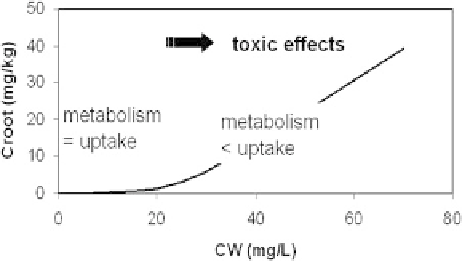Environmental Engineering Reference
In-Depth Information
Fig. 9.10
Calculation of
concentration in roots of
cyanide as a function of the
concentration in external
aqueous solution (C
W
), using
Michaelis-Menten kinetics
for metabolism;
v
max
is
6.9 mg kg
−
1
h
−
1
;
K
M
is
0.44 mg L
−
1
(Larsen et al.
2005
)
small, and that it is likely that all investigated plants used the same enzyme for
detoxification. Another sign for common pathways and rates of metabolism in plant
species is the difficulty to find selectively acting herbicides: it is rare that a toxin hits
weeds but not crops (Börner
1995
).
9.7 Environmental Variables
Which contaminants are taken up into plants and the variation in the affinity for
uptake, and hence accumulation, depends also on environmental parameters. The
importance of some of these parameters is investigated in this section by using the
models described before and some experimental results.
9.7.1 Climate
Principally, the models can be adapted to all climatic conditions at which plants
grow. In particular temperature influences uptake and fate of xenobiotics in various
ways. At higher temperatures plant physiological processes such as transpiration,
growth and metabolism are stimulated. According to
Claudius-Clapeyron
's law, the
vapor pressure increases exponentially with temperature, so the vapor pressure of
water in air is 872 Pa at 5
◦
C but 5635 Pa at 35
◦
C, i.e. a factor of 6.5 higher.
The potential transpiration is directly proportional to the vapor pressure of water.
Similarly, metabolic reactions are stimulated at higher temperatures. For example,
the removal rate of cyanide was 3
5 times higher at 30
◦
C than at 11
◦
C (Yu et al.
2005a
,
2007
). Also, contaminant properties change with temperature. Like the vapor
pressure, the partition coefficient air to water,
K
AW
also increases exponentially with
temperature. For chlorinated solvents, such as TCE, the
K
AW
at 5
◦
C is about a factor
of 3 below that at 35
◦
C (Kühne et al.
2005
). This means less accumulation in leaves
and more volatilization to air at higher temperatures.
−

Search WWH ::

Custom Search